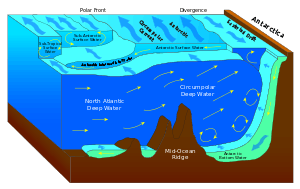Mesopelagic zone
| Pelagic | |
| Photic | |
| Epipelagic | |
| Aphotic | |
| Mesopelagic | |
| Bathyalpelagic | |
| Abyssopelagic | |
| Hadopelagic | |
| Demersal | |
| Benthic | |
| Pycnocline | |
| Isopycnal | |
| Chemocline | |
| Halocline | |
| Thermocline | |
| Thermohaline | |

The mesopelagic (Greek μέσον, middle) (also known as the middle pelagic or twilight zone) is that part of the pelagic zone that extends from a depth of 200 to 1000 metres (~660 to 3300 feet)[1] below the ocean surface. It lies between the photic epipelagic above and the aphotic bathypelagic below, where there is no light at all.
Physical conditions
Although the temperature varies less at any one height than the epipelagic, the mesopelagic is the location of the thermocline; and in warmer regions of the world, the temperature varies from over 20 °C (68 °F) at the top to around 4 °C (39 °F) at the boundary with the bathyal zone. Water generally moves slowly in the mesopelagic with a residency time of about a century[2] though a variety of animals move vertically through the zone on a daily basis and various debris sink down in relatively short time frames.
Ecology
Although some light penetrates as deep as the mesopelagic zone, it is insufficient for photosynthesis. The general types of life forms found are daytime visiting herbivores, detritivores feeding on dead organisms and fecal pellets, and carnivores feeding on the former types.[3]
Examples of animals in the mesopelagic zone are: swordfish, squid, wolf eels, cuttlefish, and other semi-deepsea creatures. Also, there is enough sunlight for animals, such as the chain catshark, to be fluorescent.
References
- ↑ Trujillo, Alan P.; Thurman, Harold V. (2010). Essentials of Oceanography (10th edition ed.). Prentice Hall. pp. 363–366.
- ↑ Hogan, Michael C. "Mesopelagic zone". The Encyclopedia or Earth. Retrieved 17 September 2013.
- ↑ Hogan, Michael C. "Mesopelagic zone". The Encyclopedia or Earth. Retrieved 17 September 2013.
See also
- Mesopelagic fish
| ||||||||||||||||||||||||||||

